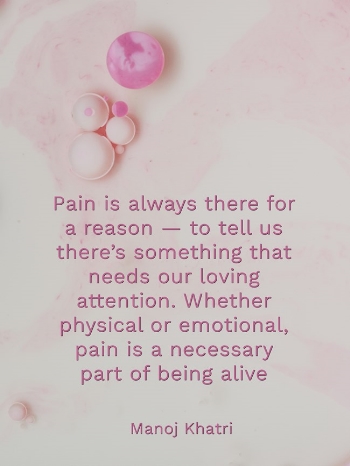How would you feel if you could eliminate all pain from your life? Blessed? If your answer is yes, may be you should think again, because pain, physical or emotional, serves an important purpose in your life. Let me explain.
Let’s say that you’re walking on the road and you have a bad fall, injuring your knees and legs severely, and fracturing your bone. Now, imagine that in spite of your injury you do not experience any pain. What would you do? Assuming nothing’s wrong, you would simply get up and attempt to walk, and, in the process of doing so, injure yourself further.
Here’s a real example of why painlessness can be a curse. A few years ago, a five-month-old baby girl named Gabby Gingras made headlines in the US when she was diagnosed with a rare disorder called hereditary sensory and autonomic neuropathy [type-5, or HSAN type-5]. In layperson’s terms, her pain-sensing nerve fibres are dysfunctional and, as a result, she feels no pain.
Nicknamed “The girl who can’t feel pain,” Gabby lacks the protective mechanism that would normally prevent her from harming herself. The outcome has been devastating, to say the least. Gabby has, albeit unintentionally, self-destructed herself, and in many ways beyond repair. Here are few instances:
- Owing to her “painlessness,” Gabby has broken her bones and suffered second-degree burns
- As a toddler she started to chew apart her tongue and mouth and she didn’t stop because it didn’t hurt. As a result, her baby teeth had to be pulled out
- Gabby once wandered around with a broken jaw, and no one noticed until she developed a fever due to an infection that developed out of the injury
- Her body temperature is unregulated, even in extreme weather. Since her body is immune to pain, she can’t feel heat, and her sweat glands don’t get activated when the mercury goes up.
- Gabby has lost one of her eyes due to excessive rubbing and scratching, and her other eye too is severely damaged.
Pain heals
In the case of little Gabby, her congenital insensitivity to pain turned out to be the worst possible curse. Her example shows that all pain exists for one reason: to heal. Of course, pain is uncomfortable in the short-term; but, it’s also indispensable to lasting health and healing. And, the best part is: once healing takes place, pain often recedes.
Pain’s purpose
All pain is a call for attention. Think of it as a plea by your body, mind or soul — to be careful and to pay attention, while healing takes place. If physical pain is a calling by the body, emotional pain is a signal that the mind, and our emotions, need to be looked at. Publilius Syrus wrote in first century BC, “The pain of the mind is worse than the pain of the body.” Today, after 2,000 years, it is perhaps truer than ever.
Given our lifestyle, each one of us experiences emotional pain from time to time. Sorrow, grief, anxiety, guilt and anger are forms of psychological pain. If you have suffered heartbreak, bereavement, a career setback, or any other distressing event, you have most likely experienced severe pain. Often, the manifestation of such emotional traumas is visible in physical ailments. Treating these ailments then, is like treating only the symptoms, which as we know, is a superficial way of dealing with a problem.
Allow, don’t resist
Any attempt to suppress pain hinders the process of healing. In case of a physical injury, if we do not attend to it and continue to carry on as if nothing had happened, we unwittingly interfere in the process of healing. In fact, many new studies prove that anti-inflammatory painkillers slow down the healing process. For instance, recent lab studies have shown that non-steroidal anti-inflammatory drugs [NSAIDs] interfere with ligament healing [Source: American Journal of Sports Medicine, March 2006]. Perhaps, the reason for this is that when we take strong painkillers, our pain sensation reduces and we are, therefore, inclined to be less attentive to the injury than we ought to be.
Deal with the cause
Best-selling author and personality mentor Anthony Robbins says that our brain has two primary driving forces: pain and pleasure. He says that no matter what we do, it boils down to doing one of the two things: avoiding pain and gain pleasure. If we’re so conditioned to combat pain all our lives, especially emotional pain, how can we learn to look at it as beneficial? The answer lies in understanding that pain is always the effect of some an imbalance.
When we face difficulties, we experience pain in the form of grief, sorrow, anger and guilt. Instead of fighting pain, which is only an effect, we would do well to identify and deal with the cause. By doing so we acknowledge the purpose of pain, which is to tell us that something is not right and must addressed.
Accepting pain as a symptom does not necessarily lessen the discomfort but it does make it more bearable as we become attuned to finding, and getting rid of, the source of the pain.
 Conclusion
Conclusion
Pain is always there for a reason — to tell us there’s something that needs our loving attention. Whether physical or emotional, pain is a necessary part of being alive. The next time you experience pain, don’t view it as something that you need to get rid of. Instead, check what it’s trying to draw your attention to. And then work on it. And don’t forget to be thankful to your pain for helping you heal whatever needs to be healed. I leave you with a quote by psychoanalyst Carl Gustav Jung: “There is no coming to consciousness without pain.”
 Spot an error in this article? A typo maybe? Or an incorrect source? Let us know!
Spot an error in this article? A typo maybe? Or an incorrect source? Let us know!
